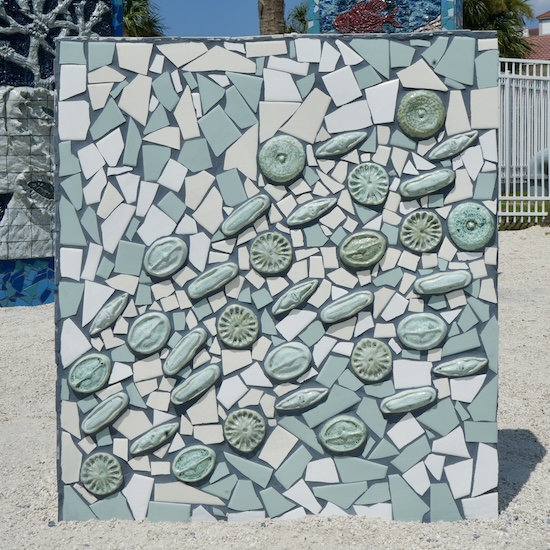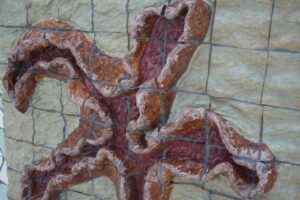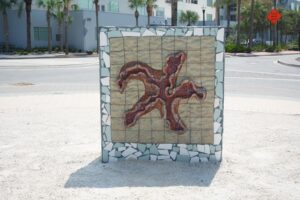Home » 2024 » Water Columns » Shoreline | Sea Star


Xavier Cortada, “Shoreline | Sea Star,” 36″ x 32″ x 8″, hand-carved, hand-glazed ceramic tile on concrete, 2024
(Water Columns series in Jacksonville Beach, FL)
Sea Star
One of seven ceramic tile works in the “Water Columns” installation, each representing a marine zone off Jacksonville Beach. This piece highlights the sea star, a keystone predator essential for maintaining balance in shoreline ecosystems, now threatened by climate change and habitat loss.
Story
Walking along our beaches, you might spot a sea star washed up on the shore. These marine animals, also known as echinoderms, aren’t just pretty to look at – they’re the star of the show as keystone predators in their ecosystems. This means they shape their marine communities by keeping mussel and sea urchin populations in check for other species to thrive.
Did you know that there are around 2,000 species of sea stars? Or that they don’t have a brain or blood? These interesting animals typically live for 35 years and can weigh up to 11 pounds!
While you can find sea stars in the sand, they live in all sorts of marine habitats, from tidal pools to coral reefs to sea grass. But warmer waters fueled by climate change are threatening sea star populations. Warmer ocean temperatures mean a rise in bacteria and organic material that deplete the oxygen that sea stars need to breathe. It also leads to sea star wasting syndrome, which dissolves their bodies. If they disappear, those marine communities will lose their balance which can lead to a major loss in biodiversity.
You can find a variety of sea stars on our beaches, including Common Sea Stars, Margined Sea Stars, and Lined Sea Stars. As beachgoers, it’s important to enjoy sea stars without touching them – since they breathe through their skin – and keep our beaches clean to keep their homes pristine.
References
- Friedlander, B. (2021, January 6). Organic matter, bacteria doom sea stars to oxygen depletion. Cornell Chronicle. https://news.cornell.edu/stories/2021/01/organic-matter-bacteria-doom-sea-stars-oxygen-depletion
- Kirsh, D. (n.d.). Echinoderms – Sea Stars Nr. 1. www.jaxshells.org. https://www.jaxshells.org/slife49ui.htm
- Ocean Conservation Trust. (n.d.). Fun facts about starfish. National Marine Aquarium. https://www.national-aquarium.co.uk/blog/fun-facts-about-starfish/#:~:text=Starfish%20belong%20to%20a%20large,a%20day%20at%20the%20beach.
- Sea Star. National Geographic Kids. (n.d.). https://kids.nationalgeographic.com/animals/invertebrates/facts/sea-star


